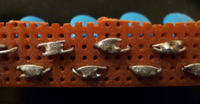redpepper007
Newbie level 4
So, basically i'm going to create a 555 based taser with somewhere about 20-30kV output (input is 9V or 3*18650 in series). Found this schematic on google and it seems kinda simple:

so I went to nearby electronics store and got all components except for the transformer. They had no idea what does 1k:8R means and asked me for input/output voltages - does anyone knows what kind of transformer would be okay? And if that matters, I'm gonna add a few more voltage multiplier stages (total of 5 or 6)

so I went to nearby electronics store and got all components except for the transformer. They had no idea what does 1k:8R means and asked me for input/output voltages - does anyone knows what kind of transformer would be okay? And if that matters, I'm gonna add a few more voltage multiplier stages (total of 5 or 6)

